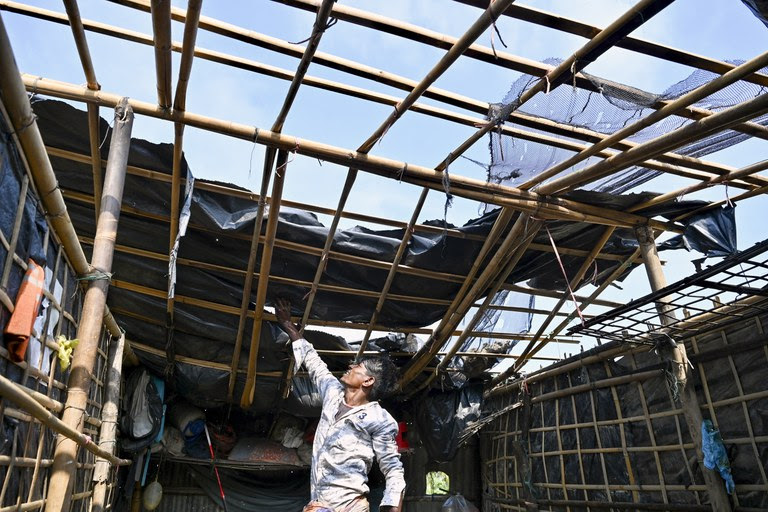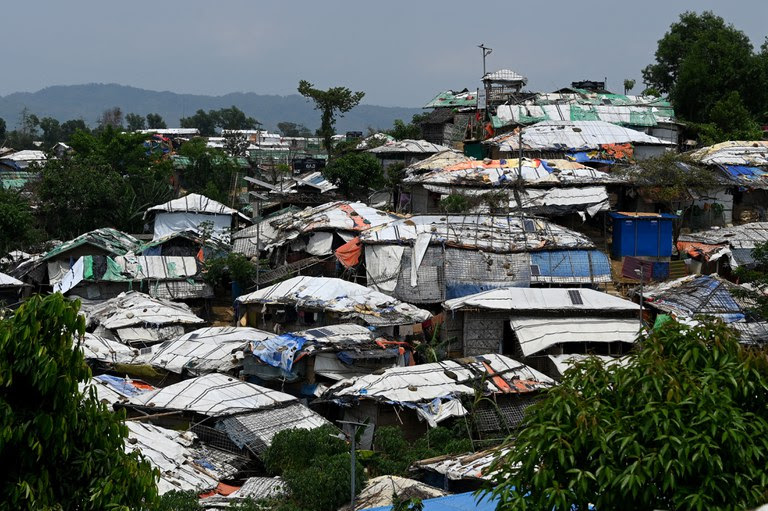
By Abdur Rahman and Sunil Barua on May 15, 2023 Benar News
Thousands of refugees’ flimsy shelters were flattened by the weekend’s powerful Cyclone Mocha in sub-districts of Cox Bazar in southeastern Bangladesh that hosts about 1 million Rohingya in sprawling camps.
Many residents’ dwellings in nearby St. Martin’s, an island in the Bay of Bengal isolated from mainland Bangladesh, suffered the same fate, although the government said no fatalities were reported as the storm hit between 3 and 5 p.m. Sunday. On the mainland, the Category 5 storm spared the city of Cox’s Bazar but caused damage in Teknaf, a town to the south that borders Myanmar’s Rakhine state, which absorbed the brunt of the cyclone.
Mocha destroyed more than 2,800 shelters, learning centers, health centers and other infrastructure in refugee camps in the neighboring sub-districts of Teknaf and Ukhia, according to Mohammed Mizanur Rahman, refugee relief and repatriation commissioner. He noted that landslides were also reported at 120 spots in the Rohingya camps.
Rahman told BenarNews there were no casualties because “we relocated them at an appropriate time.”
In Teknaf, people in six villages saw their homes destroyed by the storm.
“I have lost everything in the cyclone. I have not eaten a handful of rice since yesterday. I have come here to search for relief,” Sufia Khatun, a woman in her 60s who lost her home on the Naaf River in Teknaf, told BenarNews on Monday.
“I have been waiting for relief since morning.”

Nur Kalima, mother of seven children, said her house was located on top of a hill in Teknaf.
“The roof, the tarpaulin was blown away while the frame of the house was washed away by run-off from the hills,” she said while noting she was waiting for government relief.
Muhammed Jubair, chairman of the Arakan Rohingya Society for Peace and Human Rights, described the shelters.
“The houses of the Rohingya are made of four bamboo pillars at four corners with a cover of tarpaulin,” he told BenarNews.

About 1 million refugees live in the camps in and around Cox’s Bazar district, including around 740,000 who fled a brutal military crackdown in Myanmar’s Rakhine state in August 2017.
One refugee described to BenarNews where the Rohingya had sheltered from the storm.
“Many of the Rohingya people took shelter at the mosques, madrassaa and NGOs’ offices. We have been preparing a list of the affected people as instructed by the authorities,” Mohammad Alam, of the Leda camp in Teknaf, told BenarNews.
Abdul Alim, who with his family operated a tea stall on St. Martin’s island, lost almost everything.
“My tea stall, thatched house, everything was blown away,” Alim told BenarNews.
Saint Martin’s island, with a blue water natural coral beach, is cut off from the mainland. The nearest mainland spot, Teknaf, is about 25 km. (15.5 miles) away.
Korban Ali, another Saint Martin’s resident, recounted how he spent the night before the cyclone made landfall at a shelter praying that his home would be spared, but it wasn’t to be.
“Mocha totally obliterated my home. Even the cooking utensils have been washed away,” he told BenarNews.
“We are a seven-member family. What will we do now?”









